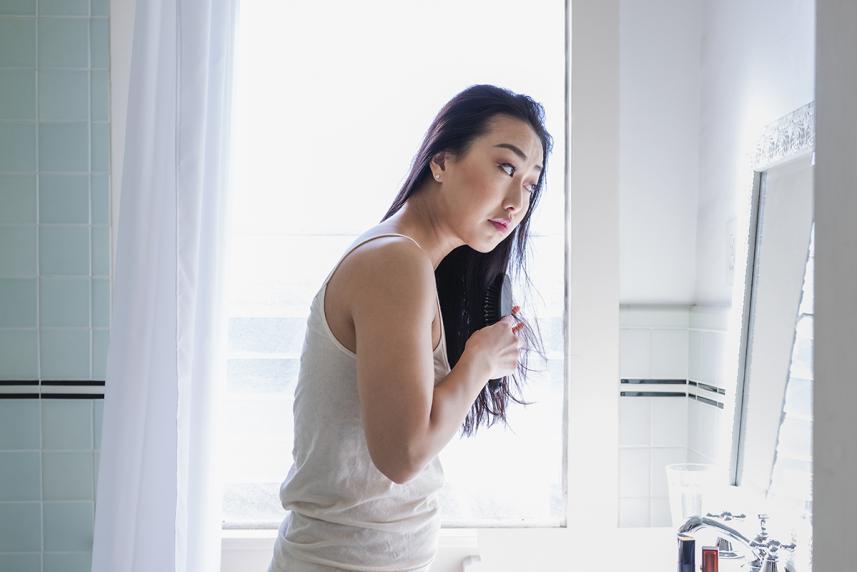
Get discreet care from the comfort of home. No appointments are required and medication can be delivered straight to your door. Plus, we're open 24/7.

It’s not always easy to tell the difference between normal hair shedding and actual hair loss. Here’s what to know.
It’s normal to shed some hair every day. But have you ever looked at the hair in the drain or on your pillow and worried that you might be headed for some serious thinning, bare patches or even baldness? It’s a good question to ask, because there is a difference between normal shedding and worrisome hair loss. Here’s what you need to know.
Hair has a natural growth cycle. Every hair on your body, including the hair on your scalp, goes through a three-stage process:
We shed hair from the scalp all the time — up to 100 hairs a day. That’s why it’s normal to see some hair on your pillow, in your brush, or in the shower every day.
Shedding is continual, says Susan Huang, MD, a board-certified dermatologist based in Irvine, California. As long as the amount that drops out remains fairly constant, it’s nothing to worry about. Normally, even though you’re constantly shedding hair, it’s also constantly growing back, so you don’t have a net loss.
There are a couple of scenarios in which shedding goes beyond the natural cycle, however. It can be alarming — but fortunately, it’s usually temporary. In addition, there are things you can do during excessive shedding to help address hair loss. Here are two common reasons:
Shedding due to a stressful event. If you experience a big increase in shedding, you may have telogen effluvium (TE). When you experience some sort of shock or body change from an extreme stressor, your body may push more hairs — typically about 30% — into telogen, the resting phase.
TE can be caused by dramatic events such as an illness, surgery, weight loss of 20 or more pounds, going off birth control pills or other stressors.
About 3 to 4 months after the triggering event, a larger than normal amount of hair may fall out, leaving behind thinning or bald patches. The good news is that TE is temporary.
“In most cases, the hair follicles will wake up by themselves,” says Rajani Katta, MD, a dermatologist who works on the voluntary clinical faculty with Baylor College of Medicine and the McGovern Medical School at the University of Texas Health Science Center at Houston. “But it can take 6 months or longer for this process to reverse itself.”

Get discreet care from the comfort of home. No appointments are required and medication can be delivered straight to your door. Plus, we're open 24/7.
Shedding hair in new mothers. This might seem like a cruel joke: You give birth to an adorable baby and your hair responds by falling out. Dermatologists refer to this condition as “excessive hair shedding,” according to the American Academy of Dermatology.
Some experts consider it a type of TE, due to the stress of childbirth and the falling estrogen levels that follow. It typically peaks about 4 months after you give birth. Around the 1-year mark, hair tends to return to its previous fullness. If the shedding persists past that point, you should consult an expert. (Learn more about women and hair loss.)
Washing your hair less often or brushing it more gently won’t make any difference in normal shedding. Yes, you notice the hairs left behind in the shower or the hairbrush, but “you’re not pulling them out,” Dr. Katta says. “You’re just gently dislodging them. They’ll fall out on their own whether you’re doing anything or not.”
Still, you don’t want to place extra tension on your hair and scalp by pulling with certain taut styles. That can damage follicles, preventing your hair from growing back and causing bald patches. Styles such as tight buns, braids or ponytails, the use of relaxers, weaves or extensions, and styling items such as hot combs may all contribute to certain forms of permanent hair loss.
(Read our guide to learn about how various types of hair loss are treated — and how to prevent it.)
In true hair loss, or alopecia, the hair follicles can become smaller. The medical term for this is “miniaturization.” As that happens, the hairs those follicles produce also become smaller in diameter and often lighter in color. Sometimes the follicles eventually stop producing hair altogether.
The most common type of hair loss is male- or female-pattern hair loss, which is caused by genes, hormones and aging.
In male-pattern hair loss, men usually see their hairline receding at the forehead and thinning at the top of the head. In female-pattern hair loss, women often have a widening and thinning at their part, so the scalp becomes more visible. It’s rare, however, for women with female-pattern baldness to lose all their hair.
If you begin to notice this type of hair loss, speak to a doctor: There are proven treatments to slow down or halt the hair loss and restore growth, and the sooner they’re started, the better they work. One of the most popular medications is minoxidil (you may know it as Rogaine®). Check out "Hair loss: The Optum Guide" for a full description of the treatments available.
If you think you need hair loss treatment, Optum's providers can help. Learn how our service works — no insurance required.
Additional sources
Hair loss types and causes: University of Michigan Health (2020). "Hair Loss"
Telogen effluvium basics: Harvard Medical School (2019). "Telogen Effluvium"
Telogen effluvium: Journal of Clinical and Diagnostic Research (2015). "Telogen Effluvium: A Review"
Shedding versus loss: American Academy of Dermatology (n.d.). "Do You Have Hair Loss or Hair Shedding?"
Post-partum hair loss: American Academy of Dermatology (n.d.). "Hair Loss in New Moms"
Hereditary hair loss: Harvard Medical School (2019). Hereditary-Patterned Hair Loss